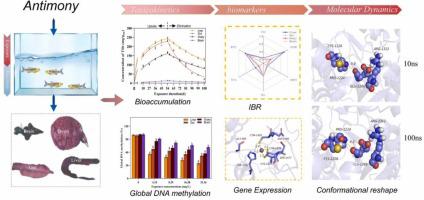当前位置:
X-MOL 学术
›
Ecotox. Environ. Saf.
›
论文详情
Our official English website, www.x-mol.net, welcomes your feedback! (Note: you will need to create a separate account there.)
Tracing toxic path of antimony: From bioaccumulation to DNA hypomethylation in zebrafish (Danio rerio)
Ecotoxicology and Environmental Safety ( IF 6.8 ) Pub Date : 2024-04-22 , DOI: 10.1016/j.ecoenv.2024.116351 Jingyun Zhang , Aijiang Yang , Wen Cui , Jian Zhang , Apin Niu , Xia Hu , Qing Li
Ecotoxicology and Environmental Safety ( IF 6.8 ) Pub Date : 2024-04-22 , DOI: 10.1016/j.ecoenv.2024.116351 Jingyun Zhang , Aijiang Yang , Wen Cui , Jian Zhang , Apin Niu , Xia Hu , Qing Li

|
The increasing concentration of Antimony (Sb) in ecological environments has raised serious concerns about its potential biotoxicological impact. This study investigated the toxicokinetics, Global DNA Methylation (GDM), biomarker expression, and Integrated Biological Response (IBR) of Sb at different concentrations in zebrafish. The toxic mechanism of Sb exposure was simulated using molecular dynamics (MD). The results showed that significant differences effect existed (BCF: liver > ovary > gut > brain) and uptake saturation phenomenon of Sb among zebrafish tissues. Over a 54-day exposure period, the liver emerged as the main target site for Sb-induced GDM, and the restoration was slower than in other tissues during the 54-day recovery period. Moreover, the concentration of Sb had a significant impact on the normally expression of biomarkers, with inhibited and and showing varying degrees of activation at different Sb concentrations. This could be attributed to Sb potentially occupying the active site or tightly binding to the deep cavity of these genes. The IBR and MD results highlighted DNMT1 as the most sensitive biomarker among those assessed. This heightened sensitivity can be attributed to the stable binding of Sb to , resulting in alterations in the conformation of 's catalytic domain and inhibition of its activity. Consequently, this disruption leads to damage to the integrity of GDM. The study suggests that DNA methylation could serve as a valuable biomarker for assessing the ecotoxicological impact of Sb exposure. It contributes to a better understanding of the toxicity mechanisms in aquatic environments caused potential pollutants.
中文翻译:

追踪锑的毒性途径:从斑马鱼(Danio rerio)的生物累积到 DNA 低甲基化
生态环境中锑(Sb)浓度的不断增加引起了人们对其潜在生物毒理学影响的严重关注。本研究研究了斑马鱼中不同浓度锑的毒代动力学、整体 DNA 甲基化 (GDM)、生物标志物表达和综合生物反应 (IBR)。使用分子动力学(MD)模拟了锑暴露的毒性机制。结果表明,斑马鱼组织之间存在显着差异效应(BCF:肝脏>卵巢>肠道>大脑)和Sb吸收饱和现象。在 54 天的暴露期内,肝脏成为 Sb 诱导的 GDM 的主要靶点,并且在 54 天的恢复期内恢复速度比其他组织慢。此外,Sb浓度对生物标志物的正常表达有显着影响,在不同Sb浓度下,生物标志物的表达受到抑制,并且表现出不同程度的激活。这可能归因于锑可能占据活性位点或与这些基因的深腔紧密结合。 IBR 和 MD 结果强调 DNMT1 是评估中最敏感的生物标志物。这种敏感性的提高可归因于 Sb 与 的稳定结合,导致 的催化结构域构象发生改变并抑制其活性。因此,这种破坏会导致 GDM 完整性受损。该研究表明,DNA 甲基化可以作为评估锑暴露的生态毒理学影响的有价值的生物标志物。它有助于更好地了解水生环境中潜在污染物引起的毒性机制。
更新日期:2024-04-22
中文翻译:

追踪锑的毒性途径:从斑马鱼(Danio rerio)的生物累积到 DNA 低甲基化
生态环境中锑(Sb)浓度的不断增加引起了人们对其潜在生物毒理学影响的严重关注。本研究研究了斑马鱼中不同浓度锑的毒代动力学、整体 DNA 甲基化 (GDM)、生物标志物表达和综合生物反应 (IBR)。使用分子动力学(MD)模拟了锑暴露的毒性机制。结果表明,斑马鱼组织之间存在显着差异效应(BCF:肝脏>卵巢>肠道>大脑)和Sb吸收饱和现象。在 54 天的暴露期内,肝脏成为 Sb 诱导的 GDM 的主要靶点,并且在 54 天的恢复期内恢复速度比其他组织慢。此外,Sb浓度对生物标志物的正常表达有显着影响,在不同Sb浓度下,生物标志物的表达受到抑制,并且表现出不同程度的激活。这可能归因于锑可能占据活性位点或与这些基因的深腔紧密结合。 IBR 和 MD 结果强调 DNMT1 是评估中最敏感的生物标志物。这种敏感性的提高可归因于 Sb 与 的稳定结合,导致 的催化结构域构象发生改变并抑制其活性。因此,这种破坏会导致 GDM 完整性受损。该研究表明,DNA 甲基化可以作为评估锑暴露的生态毒理学影响的有价值的生物标志物。它有助于更好地了解水生环境中潜在污染物引起的毒性机制。



























 京公网安备 11010802027423号
京公网安备 11010802027423号